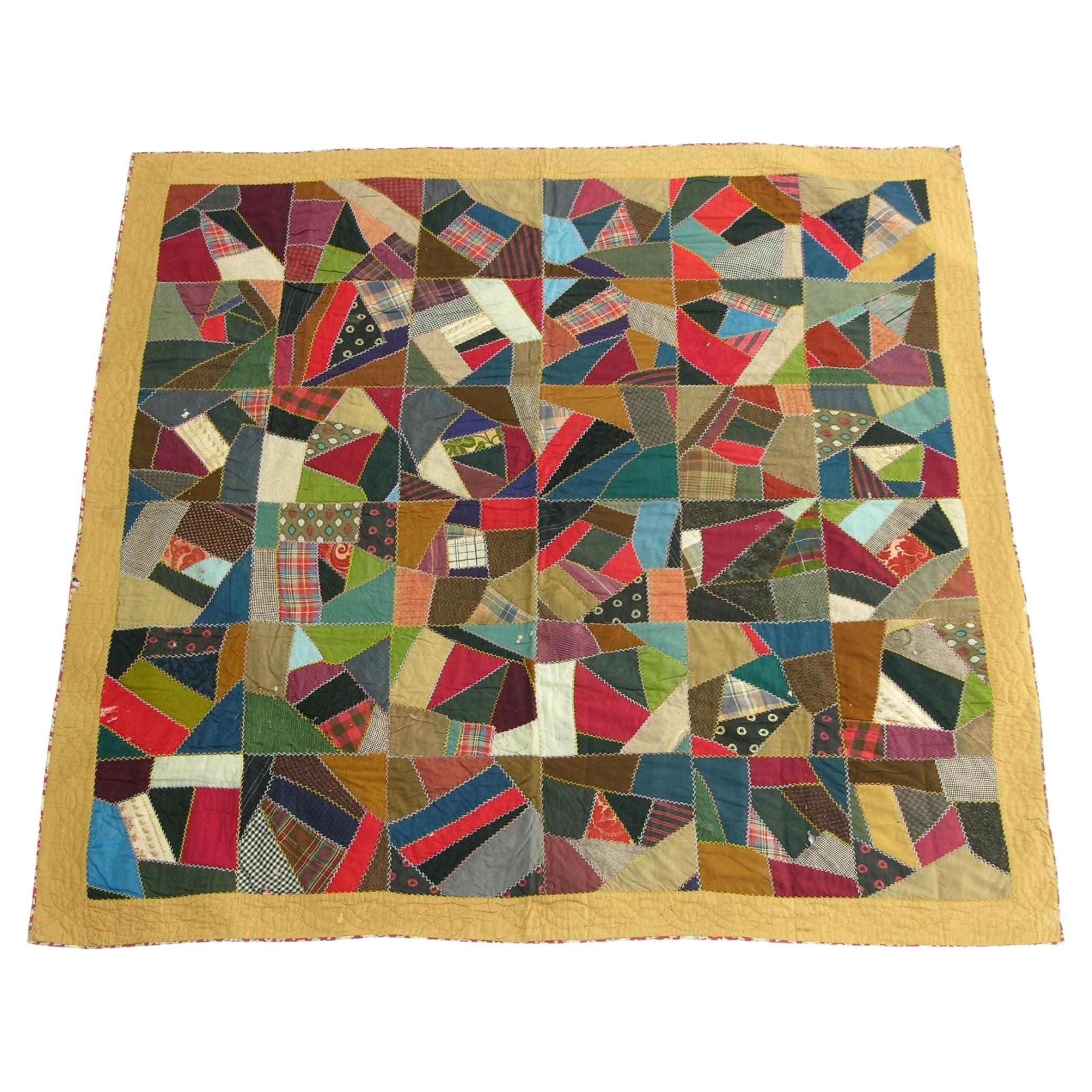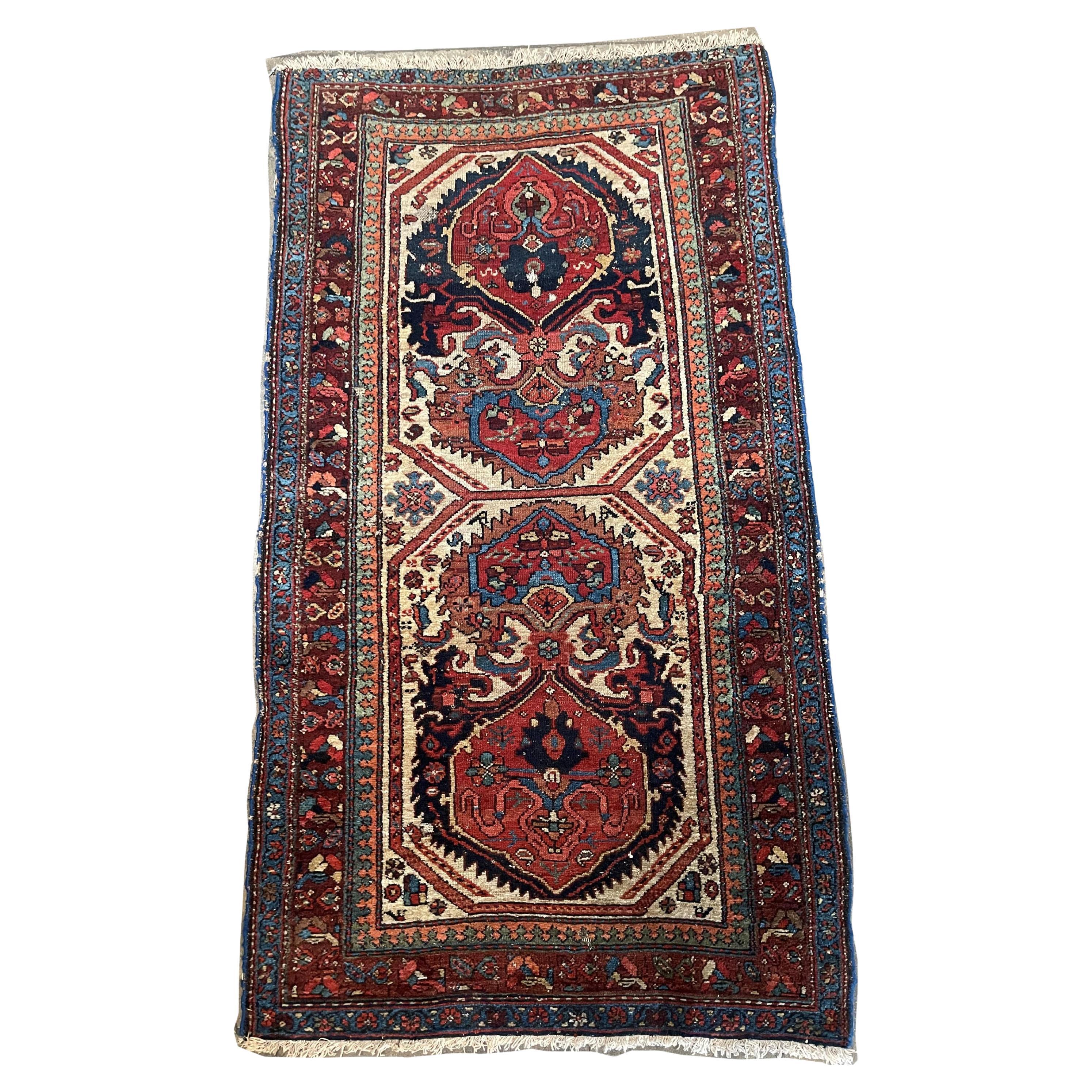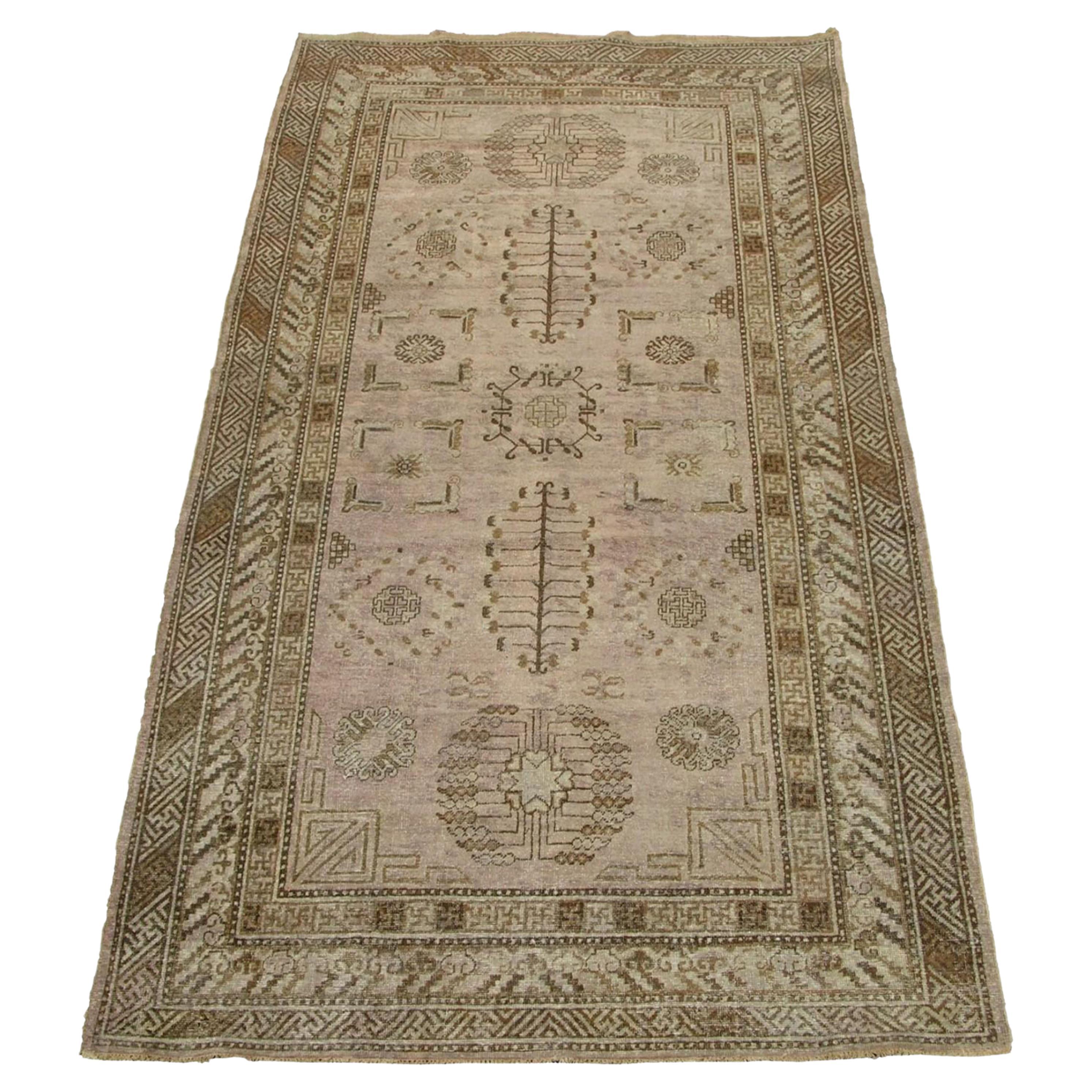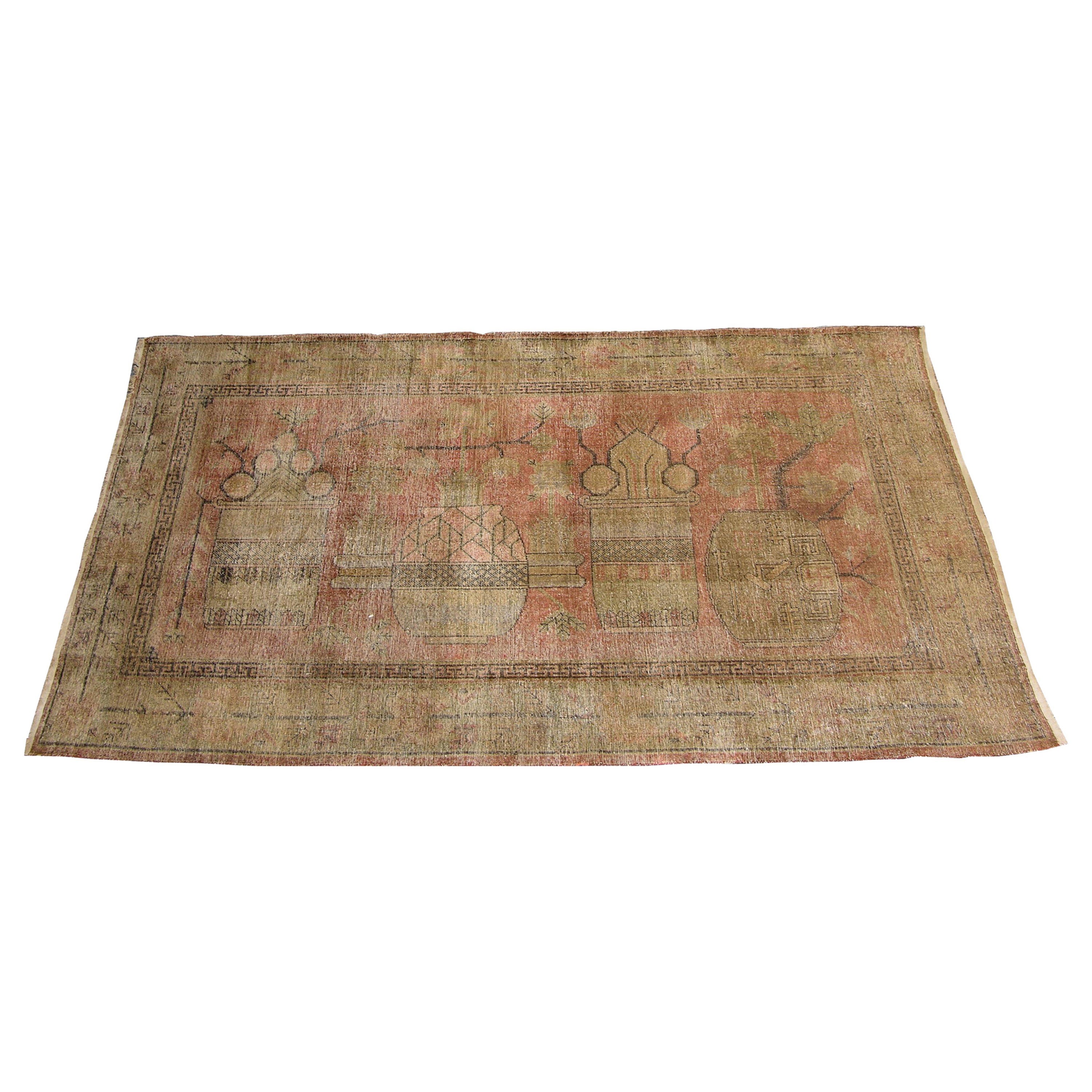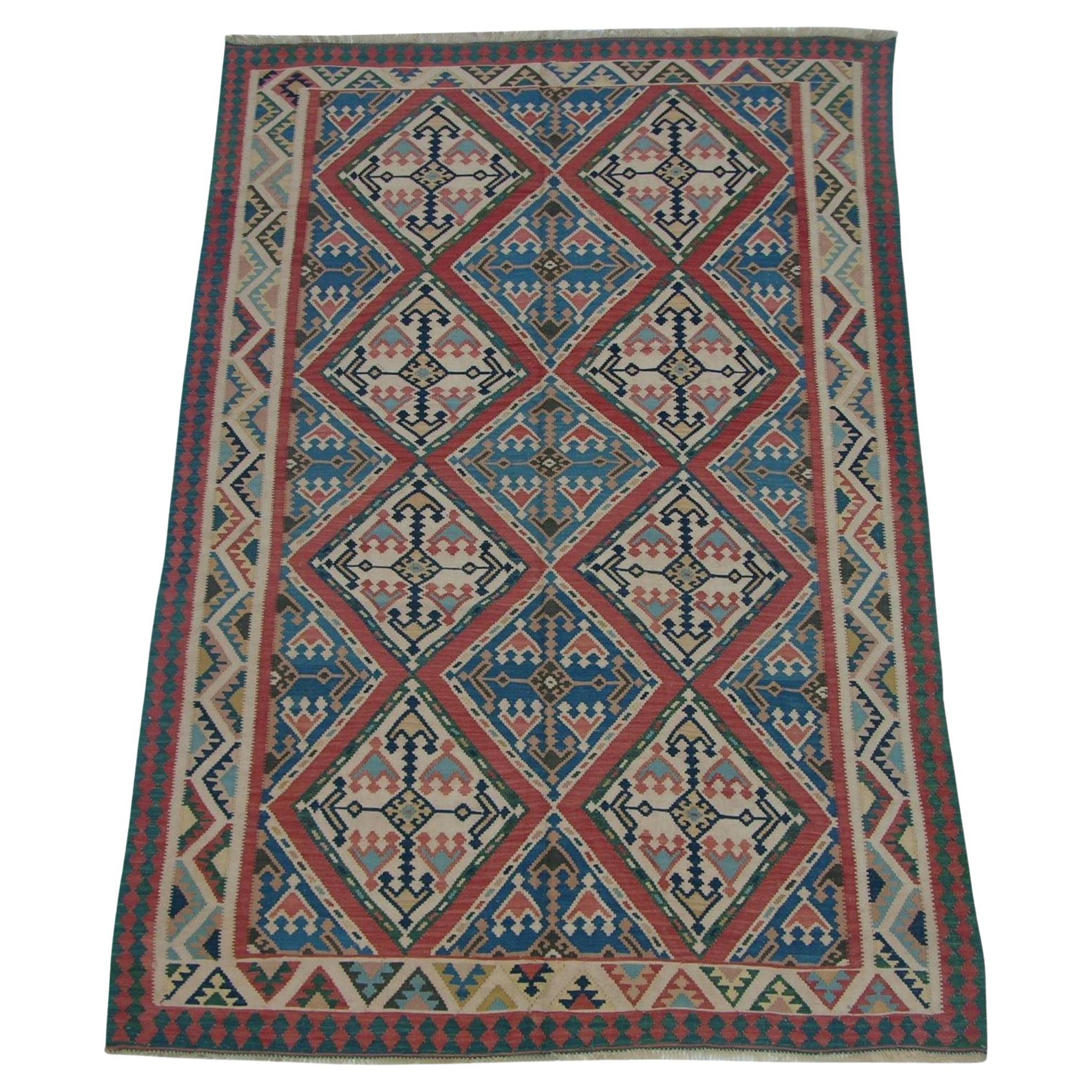Items Similar to 1920s Antique Fine Turkish Oushak Rug
Want more images or videos?
Request additional images or videos from the seller
1 of 5
1920s Antique Fine Turkish Oushak Rug
About the Item
Antique Turkish Oushak rugs have been woven in Western Turkey since the beginning of the Ottoman period. Historians attributed to them many of the great masterpieces of early Turkish carpet weaving from the 15th to the 17th centuries. However, less is known about what happened to production there in the 18th and early 19th centuries.
When things become more clear toward 1900, the Oushak region re-emerges as a major center, this time for room-size decorative rugs. Antique Turkish Oushak rugs such as these are desirable today as highly decorative pieces. They come in central, or small allover medallion designs as well as scattered sprays of vine scroll and palmettes. They are notable for the grand, monumental scale of the designs, often a subdued palette in soft apricot and golden saffron tones whose pleasing qualities are enhanced by their particularly soft and lustrous wool.
“Cosmopolitan” and “sophisticated” are two words that aptly describe Oushak rugs. Although the Ghiordes knot and the quirky angular designs have a certain primitive air, the rugs from Turkey are exceptionally unique and attractive. Without compromising to appeal to Western consumers, weavers here managed to create one of the country’s most desirable rug styles. The angular arabesques and ornamental medallions are not dissimilar from Persian motifs but are executed in a more rectilinear manner and woven in a unique palette that includes bold Mediterranean-influenced colors and chic pastels.
The Oushak rugs have become the rugs of choice for many of the top interior decorators in the world today. Just open any copy of architectural digest and you will see these magnificent carpets adorn the floors of many bedrooms, family rooms and living room floors.
For the most part they are not high quality rugs but that is what makes them so special. Since the knot count is considerably lower than the antique rugs made in Persia – antique Turkish rugs were woven with larger scale patterns. These carpets are also extremely desirable because of their colors – which are usually much lighter and “happier” in feel than rugs from other regions. So if you are looking for an antique or vintage rug with a large scale design and soft colors, theses should top your list.
It is generally believed that rug making in Anatolia began with the advent of the Seljuks in the 11th century. By the 15th century, rugs were being produced by factories and independent weavers in the environs of Oushak. The origins of of the rugs from Oushak must therefore be looked for between these two dates. The rugs of the 15th, 16th, and 17th centuries were widely acclaimed in Europe where they were appreciated and depicted in the paintings of many artists such as Lorenzo Lotto and Hans Holbein. During the 18th century the production of Oushak rugs had deteriorated and became much more commercial.
Although the Oushak rugs are made using less complicated methods, they are extremely decorative in nature. Their larger scale patterns, along with their soft and decorative coloration, make these rugs extremely sought after by the trend-setters and taste-makers in the interior design trade.
From a relatively early time, during the Ottoman period, the town of Oushak, in western Turkey, has been a major center of rug production. Many of the great masterpieces of early Turkish rug weaving from the 15th to the 17th centuries have been attributed to this center.
After the 17th century, however, the development of Oushak rug weaving is less well known. A number of very large palatial scale carpets of 18th century date have been attributed to Oushak, and also to the town of Smyrna further to the West on the coast of Turkey. The great star and medallion antique Oushak carpets of the late 15th to 17th century were made there, and it is even possible that the various carpets of the so-called “Holbein” type of family were products of Oushak as well. To say the very least, Oushak has a major claim to a long and distinguished tradition of rug weaving which has continued right up into modern times.
The later Oushak or Smyrna carpets tend to have elements derived from the medallion and Star Oushaks, but arranged as allover designs, and in a much coarser or robust weaving technique that corresponded to the large size of the carpets and their designs. As far as we can tell, rugs of this sort continued to be woven into the 19th century although in far fewer numbers. This 18th and earlier 19th century development should be seen within the larger setting of Oriental rug production at this time, which was a period of decline, not in quality but in scale because of the falling off of the European market.
European taste had moved away from Oriental rugs in favor of local European productions. Examples of these European weaving companies are Aubusson, Savonnerie and Axminster which produced carpets in a native, classically derived, European style.
Against this background it would seem that the larger 18th, and early 19th century Oushak or Smyrna carpets, were made for affluent local Turkish consumption.
It is no surprise that theses rugs are sought after. Their bold and embellished designs are the definition of antique style. In soft wool and muted palates, they project a soulful grace that balances everything from mid-century modern decor to old fashioned elegance. These rugs originated in the western Turkish town of Oushak, or Ushak. Through the 15th to 16th centuries, Turkey was a hub of carpet craftsmanship. But by the 1900’s, Oushak became the stand-out center with their decorative, room-sized masterpieces. Often crafted in subtle tones of apricot and saffron, these antique carpets are a favorite among designers for their versatility and particularly soft texture. What we love most about Turkish antique rugs from Oushaks is how they capture primitive design in cosmopolitan style. Persian motifs and angular arabesques project the soulfulness of history, but the overall affect is read as nothing short of sophistication. These are the sort of antique carpets that steal the spotlight in any room, complimenting changing design trends with their timeless style.
All this changed after the middle of the 19th century when Ushak, now Oushak, re-emerged as a major center of production in keeping with the larger revival of oriental rug production in Turkey and Persia at this time. A large and expanding middle class in the Europe and the United States created a sudden new demand for antique Oriental rugs, and like the many other rug producing centers with a long history behind them at this time, Oushak quickly rose to meet it.
We might expect the weavers of the Oushak region at this time to have embarked on a major revival of their greatest hits from their heyday in the Ottoman period, with copies or adaptations of Star and Medallion Oushak types and the like, but this is exactly what did not happen. Times had definitely changed, and Persia had initially taken the lead in the new production of rugs for the western market.
Consequently, it was the floral designs of Persian type, both in medallion and allover formats, that now commanded the market, and it was designs of this type that the Oushak weavers began to develop. And they adapted to this new demand for room size decorative carpets very quickly and in the most remarkable ways.
Oushaks like this were competing with the Ziegler, Mahal or Sultanabad production in contemporary Persia. But their color sensibility is softer and more delicate in keeping with the lustrous silky wool that is the hallmark of the best Oushak carpets.
During the century and a half or so after 1700, when the European appetite for Oriental rugs had fallen off, the volume of workshop weaving in Oushak must have diminished considerably.
When the Western appetite for Oriental carpets suddenly increased in the later 19th century, the number of weavers still active in Oushak itself could not have met this demand, so the town manufactures had to turn to the village weavers of the surrounding areas who had maintained a continuous weaving tradition for centuries. Such village weavers had tended to produce smaller rugs with a strong tribal sensibility. They made rugs with bold geometric designs and rugged kinetic drawing, using large knots and all-wool foundations.
- Dimensions:Width: 82 in (208.28 cm)Length: 118 in (299.72 cm)
- Style:Tribal (In the Style Of)
- Materials and Techniques:
- Place of Origin:
- Period:1900-1909
- Date of Manufacture:1900
- Condition:Great Condition.
- Seller Location:Los Angeles, US
- Reference Number:
About the Seller
5.0
Gold Seller
These expertly vetted sellers are highly rated and consistently exceed customer expectations.
Established in 1920
1stDibs seller since 2023
27 sales on 1stDibs
Typical response time: <1 hour
- ShippingRetrieving quote...Ships From: Los Angeles, US
- Return PolicyA return for this item may be initiated within 3 days of delivery.
More From This SellerView All
- 1920s Antique Patchwork RugLocated in Los Angeles, USAntique rugs that are called “Kilim rugs”, primarily refer to a type of flat weave rug that was produced without knotted pile. Because these antique rugs are found across the globe, ...Category
Antique Early 1900s Asian Other Russian and Scandinavian Rugs
MaterialsWool, Cotton
- 1920s Antique Hamedan RugLocated in Los Angeles, USShirvan rugs – The historic Khanate or administrative district of Shirvan produced many highly decorative antique rugs that have a formality and stylistic complexity that is found in...Category
Antique Early 1900s Asian Other Russian and Scandinavian Rugs
MaterialsWool, Cotton
- 1920s Antique Samarkand RugLocated in Los Angeles, USAntique Samarkand Rugs: The desert oasis of Khotan was an important stop on the Silk Road. The people of Khotan were expert carpet weavers who produced high quality antique rugs and ...Category
Vintage 1920s Other Russian and Scandinavian Rugs
MaterialsWool, Cotton
- 1920s Antique Samarkand RugLocated in Los Angeles, USAntique Samarkand Rugs: The desert oasis of Khotan was an important stop on the Silk Road. The people of Khotan were expert carpet weavers who produced high quality antique rugs and ...Category
Vintage 1920s Other Russian and Scandinavian Rugs
MaterialsWool, Cotton
- 1920s Antique Geometric Kilim Rug 6'8''x 3'5''Located in Los Angeles, USAntique rugs that are called “Kilim rugs”, primarily refer to a type of flat weave rug that was produced without knotted pile. Because these antique rugs are found across the globe, ...Category
Vintage 1920s Asian Tribal Russian and Scandinavian Rugs
MaterialsWool
- 1920s Antique Swedish Kilim RugLocated in Los Angeles, USAntique rugs that are called “Kilim rugs”, primarily refer to a type of flat weave rug that was produced without knotted pile. Because these antique rugs are found across the globe, ...Category
Antique Early 1900s Asian Other Russian and Scandinavian Rugs
MaterialsWool, Cotton
You May Also Like
- Antique Russian Tekke Turkman Rug from 1920sLocated in New York, NYAntique Russian Tekke Turkman rug from 1920s ( 3' 6" x 6' - 106 x 182 cm).Category
Antique Early 1900s Russian Russian and Scandinavian Rugs
MaterialsWool
- Bessarabian Kilim Rug, c.1920sLocated in Savannah, GAA Bessarabian Kilim rug, circa 1920s. 76 by 117 inchesCategory
Vintage 1920s Moldovan Other Russian and Scandinavian Rugs
MaterialsWool
- Turkish Marby Design Oushak RugLocated in Lohr, Bavaria, DEOne of a kind Turkish hand-knotted design rug. Very unusual in style and color. Hand-knotted with soft wool on wool warp and weft. Oushak Marby rug Turkey 9.6 x 8.0 ft / 294 x 243 cm...Category
Late 20th Century Turkish Turkish Rugs
MaterialsWool
- Unique Antique Turkish Oushak Rug, circa 1920sLocated in New York, NYThe gold inner field with expanded stepped ecru petal flower corners hosts the empty brownish dark gray field with a floating pendanted light rose ...Category
Vintage 1920s Turkish Oushak Turkish Rugs
MaterialsWool
- Turkish Oushak Rug, circa 1920sLocated in New York, NYThis good condition Turkish village scatter shows a tomato red stepped subfield centered by an ivory octogramme sub-medallion surrounded by an ivory stepped square-ended surround. Th...Category
Vintage 1920s Turkish Oushak Turkish Rugs
MaterialsWool
- Hamadan Vintage Olive Green Rug Circa 1920sLocated in New York, NYOverwashed, modern aesthetic, faded olive Hamadan rug (Persian) with beautiful allover fieldCategory
Early 20th Century Russian and Scandinavian Rugs
MaterialsWool
